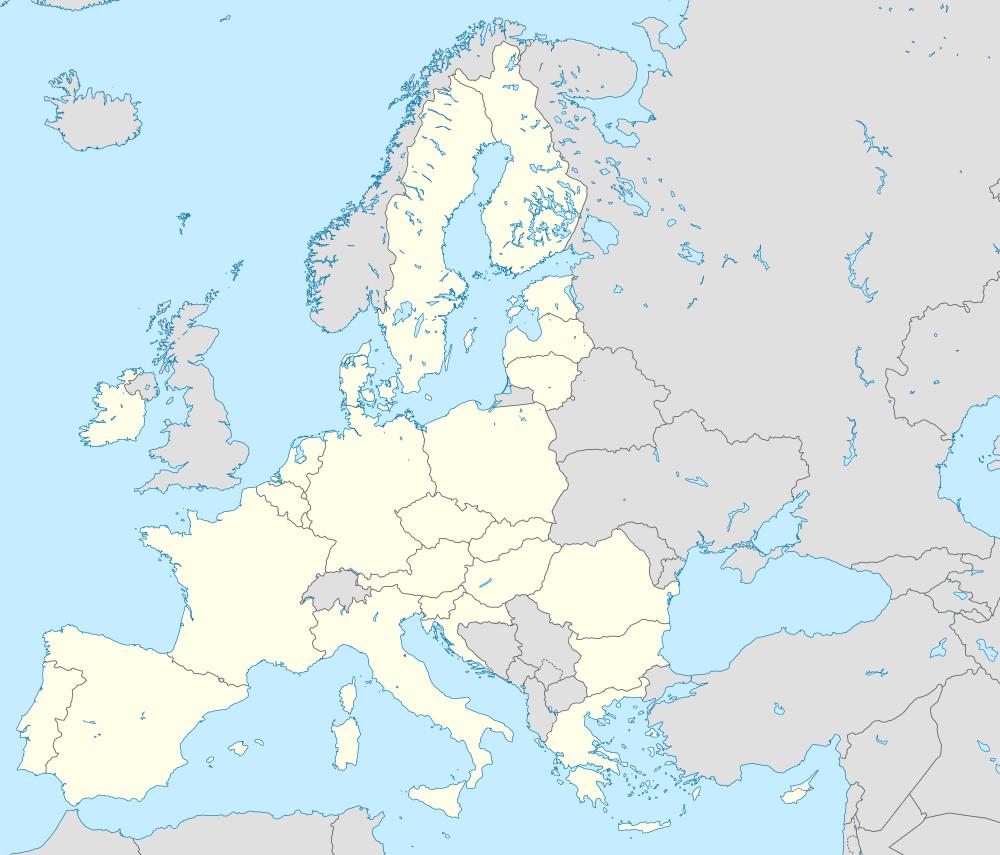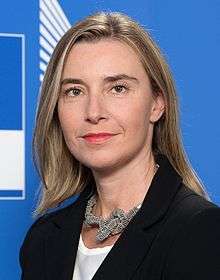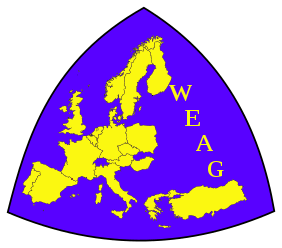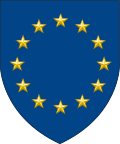European Defence Agency
The European Defence Agency (EDA) is an agency of the European Union (EU) that promotes and facilitates integration between member states within the EU's Common Security and Defence Policy (CSDP). The EDA is headed by the High Representative (HR/VP), and reports to the Council. The EDA was established on 12 July 2004 and is based in the Kortenberg building in Brussels, Belgium, along with a number of other CSDP bodies.
 | |
| Military overview | |
|---|---|
| Formed | 12 July 2004 |
| Jurisdiction | European Union |
| Headquarters | Rue des Drapiers 17-21, Brussels, Belgium |
| Annual budget | €34,1 million (2020)[1] |
| Military executives |
|
| Key document | |
| Website | eda.europa.eu |
| Map | |
 Brussels European Defence Agency (European Union) | |
All EU member states take part in the agency, except Denmark, which has opted out of the CFSP.[2]
The EDA and the European External Action Service (EEAS) together form the Secretariat of the Permanent Structured Cooperation (PESCO), the structural integration pursued by 25 of the 27 national armed forces of the EU since 2017.[3]
Mission
Tasks
The Council established the EDA "to support the Member States and the Council in their effort to improve European defence capabilities in the field of crisis management and to sustain the European Security and Defence Policy as it stands now and develops in the future”. Within that overall mission are four functions;[4]
- Development of defence capabilities in the field of crisis management.
- Promotion and enhancement of European armaments cooperation.
- Working to strengthen the Defence Technology and Industrial Base and for the creation of an internationally competitive European Defence Equipment Market.
- Enhancement of the effectiveness of European Defence Research and Technology.
Strategies
The tasks have been distilled into four strategies:[5]
- The Capability Development Plan (CDP) provides to Member States an auditable picture and assessment of capability trends and requirements, over the short, medium and long term, in order to inform national decisions on defence investments; this includes the identification of areas for cooperation for capability improvement, and the proposal concerning options for collective solutions. The CDP is the overall strategic tool, the ‘driver’ for R&T investment, for armaments cooperation and for the defence industries.
- The European Defence Research & Technology (EDRT) strategy aims at enhancing more effective R&T in support of military capabilities. The EDRT strategy defines the ‘Ends’ (in which key technologies to invest), the ‘Means’ (how to do this) and the ‘Ways’ to implement the ends and means through roadmaps and action plans.
- The European Armaments Cooperation (EAC) strategy is focussed on promoting and enhancing more effective European armaments co-operation in support of CSDP capability needs. The EAC strategy defines how to improve the effectiveness and efficiency of European armaments programmes by a series of actions, applying lessons learned from past experiences through a ‘Guide to Armaments Co-operation Best Practice’.
- The European Defence Technological and Industrial Base (EDTIB) strategy describes the future European defence industrial landscape, based on the three Cs: Capability-driven, Competent and Competitive. The future EDTIB has to be more integrated, less duplicative and more interdependent, with increased specialisation, for example by establishing industrial centres of excellence. It refers to action fields for which Governments will be responsible, such as consolidating demand and investment. Logically, the strategy links the work on realising the future EDTIB to the Agency's activities on the European Defence Equipment Market. Special attention is paid to the importance of Small- and Medium-sized Enterprises with their typical flexibility and capacity to innovate.
Organisation

The EDA structure as of 19 January 2018:
| Steering board chaired by the High Representative | |||||||||||||||||||||||||||||||||||
| Chief Executive | |||||||||||||||||||||||||||||||||||
| Deputy Chief Executive | |||||||||||||||||||||||||||||||||||
| Cooperation, Planning & Support | Capabilities, Armament and Technology | European Synergies & Innovation | Corporate Services | ||||||||||||||||||||||||||||||||
The Agency is monitored and managed in three ways.[2]
Head
The EU High Representative (HR), currently Josep Borrell, acts as the Head of the EDA. The Head is responsible for overall organisation and functioning, ensures implementation of guidelines and decisions and chairs ministerial meetings of Steering Board.
HR Javier Solana was the inaugural head of the EDA, a position which he maintained from 2004 to 2009.
Steering Board
The EDA Steering Board is the agency's decision making body. The Steering Board is composed of the defence ministers of participating Member States together with a representative of the European Commission and led by the Head of the Agency.[4] The Steering Board is responsible for projects such as the proposed pan-European Future Transport Helicopter.[6][7]
Chief Executive Officer
The Chief Executive Officer, appointed by the HR, is the agency's head of staff, responsible for supervision and co-ordination of units.[8]
| Name | Nationality | Term of office |
|---|---|---|
| Nick Witney[10] | 2004-2007 | |
| Alexander Weis | 2007-October 2010 | |
| Vacant | October 2010-January 2011 | |
| Claude-France Arnould | January 2011-February 2015 | |
| Jorge Domecq[8] | February 2015 – January 2020 | |
| Jiří Šedivý[11] | April 2020 – Present | |
The post of chief executive was vacant from October 2010 until January 2011, when HR Catherine Ashton appointed Claude-France Arnould in succession to Alexander Weis.[12] It was reported that this nomination had been blocked by the Italian government of Enrico Letta which wished to see its own candidate take up the post.[13]
In 2020 Olli Ruutu was appointed Chief Executive ad-interim by the High Representative / Vice President and Head of the European Defence Agency (EDA) Josep Borrell.[14] His mandate began on 1 February 2020 and will run until the appointment of a new Chief Executive. On 5 March 2020 the EDA Steering Board appointed Jiří Šedivý, former Czech Defence Minister, as new EDA Chief Executive upon recommendation of the Head of the European Defence Agency Josep Borrell. He will take office in April 2020 [15].
Directorates
Industry Synergies & Enablers Directorate
The Industry Synergies & Enablers Directorate supports a range of activities critical to collaborative defence capability development in Europe. On top of leading the work on identifying, together with Member States, Key Strategic Activities (KSA) at EU level, the ISE Directorate is responsible for the effective engagement with industry across the Agency’s activities and in support of related priorities set by Member States.
The ISE Directorate facilitates work to address the implications of EU legislation and policies for the defence sector: REACH, procurement, funding instruments and the analysis of developments influencing governmental and industrial stakeholders.
Research, Technology & Innovation Directorate
The Research, Technology & Innovation Directorate promotes and supports defence research at EU level. Based on the Overarching Strategic Research Agenda (OSRA), developed together with the Member States, the Directorate coordinates and plans joint research activities and the study of technical solutions to meet future operational needs.
The RTI Directorate provides support to Member States and to the European Commission for the Preparatory Action for defence research, including its implementation, and the research dimension of the European Defence Fund. The Directorate also ensures the promotion of innovation in defence and the exploitation of synergies at EU level with civil research in dual-use technology fields.
Capability, Armament & Planning Directorate
The Capability, Armament & Planning Directorate supports the coherent development of the European defence landscape by integrating EDA’s involvement in the Capability Development Plan (CDP), the Coordinated Annual Review on Defence (CARD) and the Permanent Structured Cooperation (PESCO). The Directorate also identifies, plans and proposes collaborative opportunities in support of EU capability development priorities and tailored to Member States’ needs, representing a coherent approach from priority setting to impact.
The Directorate is in charge of elaborating the Capability Development Plan, based on the analysis of military requirements conducted together with Member States. It also identifies output- oriented EU capability development priorities and coordinates the development of Strategic Context Cases to facilitate the implementation of these priorities.
Budget
The agency is financed by its members in proportion to their Gross National Income. An effect of this is that some nations pay different contributions towards the budgets than others. For example, in 2007[18] the biggest budgetary contributor was Germany at a cost of €4,202,027 followed by the United Kingdom paying €3,542,487, and France paying €3,347,139.
This budget covers the Agency's operating costs. Individual projects are funded separately.
| Year | Budget (€ millions) | Expenditure (€ millions) |
|---|---|---|
| 2004 | 1.9 | 0.4 |
| 2005 | 20.7 | 12.8 |
| 2006 | 22.7 | 18.8 |
| 2007 | 22.4 | 21.5 |
| 2008 | 27.5 | 26.2 |
| 2009 | 29.2 | 28.1 |
| 2010 | 31.0 | 30.5 |
| 2011 | 30.5 | 30.5 |
| 2012 | 30.5 | 30.5 |
| 2013 | 30.5 | 30.5 |
| 2014 | 30.5 | 30.5 |
| 2015 | 30.5 | 30.1 |
| 2016 | 30.5 | 30.5 |
| 2017 | 31.0 | 31.0 |
| 2018 | TBD | |
In its draft budget for the period 2021-2027, the European Commission will allocate €27.5 billion for defence and security.[20]
History

The European Defence Agency is part of several decades of steadily more formal defence cooperation in Europe. Its work is a continuation of the work of the Western European Armaments Organization (WEAO) and the Western European Armaments Group (WEAG) – it effectively represents the transference of their functions from the WEU to the EU framework, and thus continues the decommissioning of the WEU. It may also be seen as growing out of the Eurofighter Typhoon project, and other collaborative defence efforts.
Initially and up until 31 December 2013 the agency was organised into five directorates.[16] On 20 November 2013 a new streamlined organisational structure, listed below, was announced which came into force on 1 January 2014.[21]
At a European Council meeting on 19 December 2013, a European Air Force (EAF) consisting of surveillance drones, heavy transport airplanes, and air-to-air refuelling planes was debated.[22] This EAF was proposed by the External Action Service of HRUFASC Catherine Ashton, and was seconded by President of the European Parliament Martin Schulz.[23] The EAF proposal was supported by Hollande, Rajoy, Letta, Tusk and Merkel who together have QMV majority on the Council. The debate was joined with a view presented by NATO Secretary General Anders Fogh Rasmussen, who maintained that "Nato will remain the bedrock of Euro-Atlantic security".[22] Rasmussen's view prevailed on the Council at this time because QMV did not take effect in Council decisions until 1 November 2014.
Relationships with non-EU European countries
The Agency signed Administrative Arrangements with Norway (2006),[24] Switzerland (2012), the Republic of Serbia (2013) and Ukraine (2015) enabling them to participate in EDA's projects and programmes without exercising voting rights. All Administrative Arrangements are approved by the European Council. The Head of the Agency is responsible for negotiating these arrangements in accordance with directives given by the EDA Steering Board.[25]
A transcript of the European Commission represented by Michel Barnier at the Berlin Security Conference stated that "[after its withdrawal from the union] the United Kingdom will, as is its wish, become a third country when it comes to defence and security issues" and that "the UK will no longer be a member of the European Defence Agency or Europol".[26]
See also
CSDP structures
Other structures
- Franco-British Defence and Security Cooperation Treaty and Downing Street Declaration
- NATO Research and Technology Organisation
- Organisation for Joint Armament Cooperation (OCCAR)
References
- "Finance". Eda.europa.eu. Retrieved 6 February 2019.
- "Archived copy". Archived from the original on 20 October 2006. Retrieved 3 June 2007.CS1 maint: archived copy as title (link)
- "Permanent Structured Cooperation: An Institutional Pathway for European Defence « CSS Blog Network". Retrieved 6 February 2019.
- "Archived copy". Archived from the original on 13 June 2007. Retrieved 3 June 2007.CS1 maint: archived copy as title (link)
- "Archived copy". Archived from the original on 20 April 2012. Retrieved 2 May 2012.CS1 maint: archived copy as title (link)
- "Rüstung: EU beschließt Bau von Helikopter" (in German). Retrieved 23 January 2018.
- "EDA and Commission to work closely together on research". Eda.europa.eu. Retrieved 23 January 2018.
- "Chief Executive". Eda.europa.eu. Retrieved 6 February 2019.
- "Nick Witney". Ecfr.eu. Retrieved 6 February 2019.
- EDA's Chief Executive
- "Catherine Ashton welcomes appointment of EDA Chief Executive". Brussels. 7 January 2011.
- Vogel, Toby (25 November 2010). "Budget casts shadow over launch of EEAS". European Voice.
- EDA's Chief Executive
- Jiří Šedivý appointed as new EDA Chief Executive
- "Organisation". About us. EDA. Retrieved 4 February 2013.
- Organisation of EDA
- EUROPEAN DEFENCE AGENCY 2007 FINANCIAL REPORT June 2008
- "Finance". Eda.europa.eu. Retrieved 6 February 2019.
- "EU defence spending about integration, not military capability - Conservative MEPs". Conservativeeurope.com. Retrieved 6 February 2019.
- "EDA Launches Streamlined Structure Brussels". EDA. Retrieved 24 November 2013.
- Waterfield, Bruno (19 December 2013). "David Cameron fights off EU army plan". Retrieved 6 February 2019 – via www.telegraph.co.uk.
- "Address to the European Council by the President of the European Parliament Martin Schulz" 19 Dec 2013 Archived 12 April 2014 at the Wayback Machine
- "Norway and the EU". Norway.no. Retrieved 6 February 2019.
- "Member States". Eda.europa.eu. Retrieved 6 February 2019.
- "Speech by Michel Barnier at the Berlin Security Conference". Retrieved 22 February 2019.
External links
| Wikimedia Commons has media related to European Defence Agency. |
- European Defence Agency Official website (eda.europa.eu)
- Council Joint Action 2004/551/CFSP of 12 July 2004 on the establishment of the European Defence Agency Official website (eur-lex.europa.eu)
- CSDP structure, instruments, and agencies, EEAS website
- European Defence White Paper EU ISS Document

